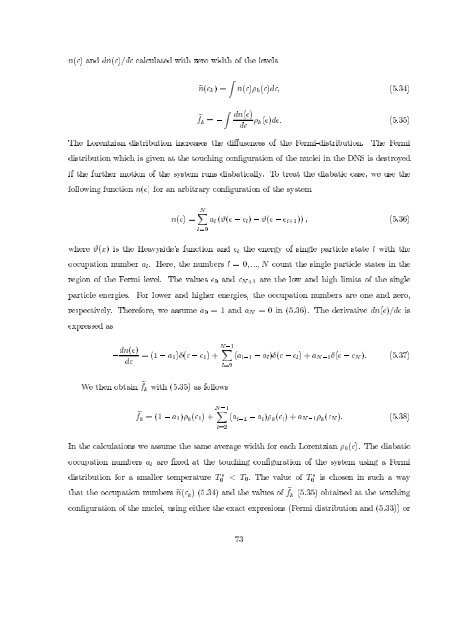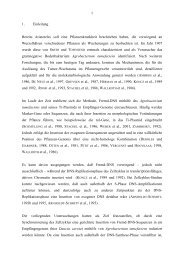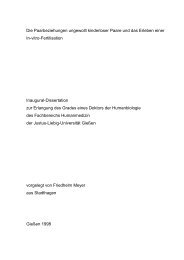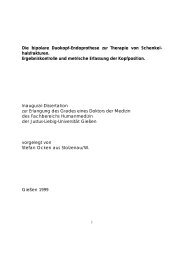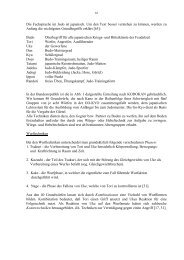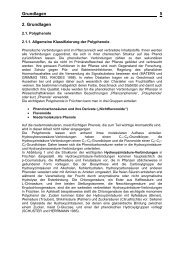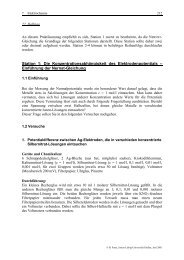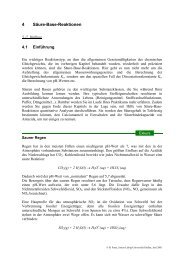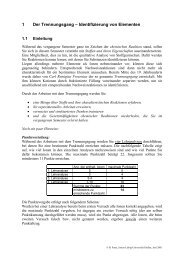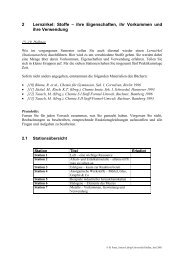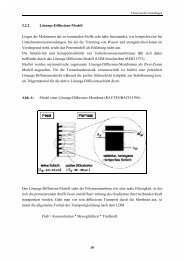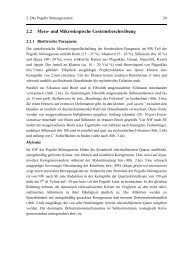Effects of diabaticity on fusion of heavy nuclei in the dinuclear model ...
Effects of diabaticity on fusion of heavy nuclei in the dinuclear model ...
Effects of diabaticity on fusion of heavy nuclei in the dinuclear model ...
You also want an ePaper? Increase the reach of your titles
YUMPU automatically turns print PDFs into web optimized ePapers that Google loves.
n(ɛ) anddn(ɛ)/dɛ calculated with zero width <str<strong>on</strong>g>of</str<strong>on</strong>g> <strong>the</strong> levels<br />
n(ɛ k)=<br />
n(ɛ)ρk(ɛ)dɛ, (5.34)<br />
k = − f dn(ɛ)<br />
ρk(ɛ)dɛ. (5.35)<br />
dɛ<br />
The Lorentzian distributi<strong>on</strong> <strong>in</strong>creases <strong>the</strong> diffuseness <str<strong>on</strong>g>of</str<strong>on</strong>g> <strong>the</strong> Fermi-distributi<strong>on</strong>. The Fermi<br />
distributi<strong>on</strong> which is given at <strong>the</strong> touch<strong>in</strong>g c<strong>on</strong>figurati<strong>on</strong> <str<strong>on</strong>g>of</str<strong>on</strong>g> <strong>the</strong> <strong>nuclei</strong> <strong>in</strong> <strong>the</strong> DNS is destroyed<br />
if <strong>the</strong> fur<strong>the</strong>r moti<strong>on</strong> <str<strong>on</strong>g>of</str<strong>on</strong>g> <strong>the</strong> system runs diabatically. To treat <strong>the</strong> diabatic case, we use <strong>the</strong><br />
follow<strong>in</strong>g functi<strong>on</strong> n(ɛ) for an arbitrary c<strong>on</strong>figurati<strong>on</strong> <str<strong>on</strong>g>of</str<strong>on</strong>g> <strong>the</strong> system<br />
n(ɛ) =<br />
N<br />
l=0<br />
a l (ϑ(ɛ − ɛ l) − ϑ(ɛ − ɛ l+1)) , (5.36)<br />
where ϑ(x) is <strong>the</strong> Heavyside’s functi<strong>on</strong> and ɛ l <strong>the</strong> energy <str<strong>on</strong>g>of</str<strong>on</strong>g> s<strong>in</strong>gle particle state l with <strong>the</strong><br />
occupati<strong>on</strong> number a l. Here, <strong>the</strong> numbers l =0,...,N count <strong>the</strong> s<strong>in</strong>gle particle states <strong>in</strong> <strong>the</strong><br />
regi<strong>on</strong> <str<strong>on</strong>g>of</str<strong>on</strong>g> <strong>the</strong> Fermi level. The values ɛ0 and ɛ N+1 are <strong>the</strong> low and high limits <str<strong>on</strong>g>of</str<strong>on</strong>g> <strong>the</strong> s<strong>in</strong>gle<br />
particle energies. For lower and higher energies, <strong>the</strong> occupati<strong>on</strong> numbers are <strong>on</strong>e and zero,<br />
respectively. Therefore, we assume a0 = 1and a N = 0 <strong>in</strong> (5.36). The derivative dn(ɛ)/dɛ is<br />
expressed as<br />
− dn(ɛ)<br />
dɛ =(1−a1)δ(ɛ ɛ1)+ −<br />
N−1<br />
<strong>the</strong>n obta<strong>in</strong> <br />
fk with (5.35) as follows<br />
We<br />
<br />
k =(1−a1)ρk(ɛ1)+ f N−1 <br />
(al−1 − al)δ(ɛ − ɛl)+aN−1δ(ɛ − ɛN ). (5.37)<br />
l=2<br />
l=2<br />
(a l−1 − a l)ρ k(ɛ l)+a N −1ρ k(ɛ N ). (5.38)<br />
In <strong>the</strong> calculati<strong>on</strong>s we assume <strong>the</strong> same average width for each Lorentzian ρ k(ɛ). The diabatic<br />
occupati<strong>on</strong> numbers a l are fixed at <strong>the</strong> touch<strong>in</strong>g c<strong>on</strong>figurati<strong>on</strong> <str<strong>on</strong>g>of</str<strong>on</strong>g> <strong>the</strong> system us<strong>in</strong>g a Fermi<br />
for a smaller temperature T distributi<strong>on</strong> ∗<br />
0 < T0. value <str<strong>on</strong>g>of</str<strong>on</strong>g> T The ∗<br />
0<br />
is chosen <strong>in</strong> such a way<br />
that <strong>the</strong> occupati<strong>on</strong> numbers n(ɛ k) (5.34) and <strong>the</strong> values <str<strong>on</strong>g>of</str<strong>on</strong>g> f k (5.35) obta<strong>in</strong>ed at <strong>the</strong> touch<strong>in</strong>g<br />
c<strong>on</strong>figurati<strong>on</strong> <str<strong>on</strong>g>of</str<strong>on</strong>g> <strong>the</strong> <strong>nuclei</strong>, us<strong>in</strong>g ei<strong>the</strong>r <strong>the</strong> exact expresi<strong>on</strong>s (Fermi distributi<strong>on</strong> and (5.33)) or<br />
73


